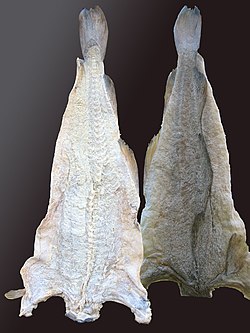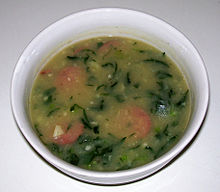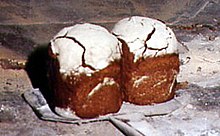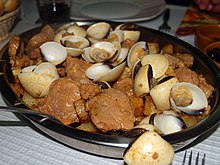Portuguese cuisine
The Portuguese cuisine is the national cuisine of Portugal . Despite the small size of the country, it is very diverse: the traditional cuisine is based on a large variety of fish and seafood, meat, vegetables, rice and potatoes; also Feijão , the bean is an important part of Portuguese cuisine, which is used in part for desserts. Stews and soups have always played an important role. Plenty of olive oil is used for the preparation . In the north, people tend to eat heartily, with lots of meat and energy-laden ingredients, especially to get through the cold winters. Cold and warm starters and snacks, the so-called petiscos, are often served. Culinary influences from the former Portuguese colonies can be found mainly in the cities and less so in the rural regions.

Soups and stews
When eating in a restaurant, soup is almost mandatory as the first course. A very traditional soup of northern Portugal is the caldo verde ("green broth"), a thin creamy potato soup with the couve galega leaves cut into thin strips , a variant of the marrow-stem cabbage , served with thinly sliced chouriço and broa , the typical corn bread . The gazpacho , a cold vegetable soup made from tomatoes , cucumbers and garlic, is very typical of southern Portugal .
Other well-known soups are the sopa de marisco (soup with seafood ), the caldeirada à fragateira , a fish soup , the xarém com conquilhas , made from cornmeal, chouriço and mussels, as well as the açorda à Alentejana , a hearty bread soup with garlic, lots of fresh coriander , often with a lost egg and olive oil.
Feijoadas are hearty bean stews, often with a Brazilian twist, which often include lots of offal, but also fine ingredients such as horn snails (búzios) or small squids (chocos).
fish and seafood
The bacalhau , a salted and dried dried fish (strictly speaking: clipfish ) is a specialty and national dish of Portugal, for which there are countless recipes. The popularity of the bacalhau is based on the fact that the Portuguese seafarers could only live on preserved food on their long voyages and this dried fish was therefore indispensable. It is available in every fish shop and market in Portugal. Cod is no longer caught off the Portuguese coast, but off Newfoundland .

Fish and all kinds of seafood play a very important role in Portuguese cuisine. Sardines , grilled as Sardinhas assadas , are very popular and are offered practically everywhere along the coast. They are particularly typical for the regions of Lisbon and Setúbal, especially around the name day of Saint Anthony of Lisbon . They also include squid , lobster , crayfish , tuna , swordfish , eel , lamb prawns , shrimp and oysters . Lobsters, giant edible crabs ( Sapateiras ) and sea spiders ( Santolas ) are freshly prepared from the aquarium in many restaurants. Ameijoas na cataplana , a mussel stew with pork , bacon and onions, is also typical . The mussels are grown in the Algarve .
Madeira is home to the specialty of the scabbard fish ( espada ), a deep-sea fish that fishermen bring from the deep sea with special fishing rods.
The Arroz de Mariscos , a rice platter with seafood such as crabs, mussels, scampi and lobster, is also very popular .
Meat dishes

In addition to beef , kid ( Cabrito ) and lamb ( Borrego ) are often eaten in Portugal . In restaurants, steak ( bife ) with rice or French fries , salad and a fried egg or with olives is very often offered. Alcatra is Terceira beef marinated with red wine and garlic . In rural regions, giblets , beef tongue and tripe are still eaten, often as a filler in stews. A well-known dish is also carne de porco com amêijoas , pork with mussels, onions and garlic, a combination of meat and seafood. In addition, turkey , duck , partridge and pigeon play a role in Portuguese cuisine today .
In the past, meat was generally not an everyday food, but a festival dish in Portugal. Most commonly, cuts of meat and sausages were used in stew dishes. A typical winter dish is the Portuguese stew Cozido à portuguesa, for which there are many recipes. A very rich variant can contain different types of meat , black pudding , pork's feet, potatoes, carrots , peas , cabbage and rice . Another hearty dish is tripas à moda do Porto , tripe with white beans that comes from Porto .
A special form of grilling meat can be found in Madeira , the espetada , pieces of meat impaled on bay sticks, which are served on special hanging devices. Lately there have been efforts to put the Azores laurel under nature protection, which is why the espetada is increasingly served on metal skewers .
The Francesinha is a toast sandwich with ham, sausage and meat in a sauce made from tomatoes, beer and mustard, which is particularly popular in Porto and the surrounding area.
The churrasco has also found its way to Portugal from the former Portuguese colonies, especially Brazil .
Petiscos

The small culinary specialties include the petiscos , such as the Bolinhos de bacalhau , deep-fried dumplings made from a Bacalhau potato mixture with egg and flat-leaf parsley. All sorts of crescent-shaped rissóis (rissol in the singular) and empanadas with fillings of crab or minced meat and cheese or barnacles .
Spices
Spices are used rather cautiously in Portuguese cuisine. Many dishes are prepared with garlic , but sparingly. Coriander , nutmeg , cloves , oregano , thyme , paprika and bay leaf as well as flat- leaf parsley also play an important role . A Portuguese specialty is piripiri , a small red chilli pepper . Sweets are made with a lot of sugar and often also with cinnamon .
cheese
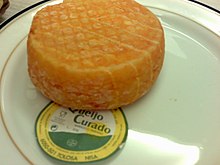
Portugal is a country with good grazing land for cows, sheep and goats and consequently a long tradition of cheese making. The most famous Portuguese cheese is Queijo da Serra - a sheep cheese from the Serra da Estrela region . Depending on the degree of ripeness, the consistency is creamy-soft in the middle and almost still runny in the case of very young Queijo da Serra to soft, but firm, in the case of older cheese. The taste is mild, soft and slightly acidic. The Queijo mestiço de Tolosa is a raw milk cheese made from goat and sheep milk and is only made during the lactation period for sheep and goats between January and July. For its production, the raw milk is thickened with an infusion of a type of thistle ( Cynara cardunculus , L. ). Cabreiro is a bitter goat cheese .
The Queijo Rabaçal is made from mixed goat and sheep milk, the Queijo de Azeitão is a rather mild sheep's cheese.
In the Azores , among other things, a hard cheese Queijo da Ilha is made, which is used like Parmesan . The best-known Azorean cheeses are Queijo do Pico and Queijo de São Jorge , both made from cow's milk. There are three milk cooperatives on Sao Jorge alone. Cheese is also made by at least one company on each of the other eight islands in the Azores.
Cheese is traditionally eaten before or after a main course.
Desserts
The influence of the Moors , who ruled the Iberian Peninsula for centuries, is particularly noticeable when it comes to desserts . Portuguese cuisine is known for high-calorie desserts based on egg yolk and sugar , for example doce de ovo (“sweet treats made from eggs”), arroz doce (“rice pudding”) and pudim caseiro (“home-made pudding”), an egg pudding with caramel sauce. Of particular importance among the total is Doçaria Conventual ( port. For: monastic confectionery), including the famous Pastel de nata . Further of these specialties are z. B. Toucinho do cèu ("Heavenly Bacon") with almonds , sugar and egg yolk, or the Ovos Moles from Aveiro . Other sweet pastries , for which figs and almonds are often used, also play an important role . The preference for sweets can be traced back to the Moorish influence, especially the frequent use of almonds and thus also of marzipan, especially in the Algarve. Chocolate , on the other hand, only plays a subordinate role.
Sweet pastries
Among the now internationally known representatives of Doçaria Conventual include Pastéis de nata , baked in puff pastry cream custard tarts, which in the 18th century in the monasteries of Santa Maria de Belém , were prepared, a district in the west of Lisbon. Furthermore, the “Queijadas de Sintra”, tartlets filled with cream cheese from Sintra , the Mil Folhas (“A Thousand Leaves”), a specialty covered in puff pastry with a pudding filling and icing, the Pastel de Tentúgal , a filled puff pastry specialty from Tentúgal , the pastéis de Feijão (“bean patties”, a bit more hearty but still sweet and juicy), almofadas (“pillows”), puff pastry specialties coated with powdered sugar and bolo de Xadrez (“chess cakes”), cakes with a checkered interior pattern and éclairs , are popular. Berliners are also known in Portugal under the name Bolas de Berlim . But these are filled with pudding or chocolate instead of jam.
In Portugal, pastries are v. a. in the Pastelaria , a mixture of bakery, pastry shop and café.
beverages
In Portugal, wine is part of the general food culture - with 500 local grape varieties that produce wines, the country has a variety to offer, which is characterized by the cool climate of the Atlantic coasts and the hot and dry climate in the interior. The typical Portuguese wines are rather undervalued internationally. Port wine , a liqueur wine that is mainly drunk with desserts , is well known beyond national borders . The fermentation process is interrupted by the addition of brandy and the characteristic taste is created during storage. The vines for this grow exclusively in the area of the Douro Valley . The Alto Douro area, which was delimited there in 1756, was the first protected wine-growing area in the world and is now a UNESCO World Heritage Site . The English in particular contributed to the popularity of the port, which they have been importing since the 18th century.
Other wines from Portugal also enjoy a good reputation internationally. The sweet version of Vinho da Madeira from Madeira is similar to Spanish sherry , but Madeira wine is available in all varieties from dry to very sweet.
Various sparkling wine specialties are produced in Portugal, such as the sparkling wine from Bairrada. The Vinho Verde ("green wine" in the sense of "young wine") is a slightly sparkling wine that gets its character through a second fermentation process of the must - the malolactic fermentation , which is otherwise only common with red wines. It leads to milder acidity and forms natural carbonic acid.
There are a number of Portuguese pomace schnapps ( aguardente ) and liqueurs , such as Licor Beirão or Ginjinha (a sour cherry liqueur ). The Macieira brandy and the Medronho strawberry tree schnapps , typical of the Alentejo and the inner Algarve , are particularly well-known .
The "national drink " of Madeira Island is poncha (punch), a cocktail made from aguard duck, lemon juice and honey. The lemon juice is sometimes replaced by other fruit juices, namely passion fruit juice. Peanuts, pickled lupine seeds (tremoços) and / or other nibbles are served.
The best-known beer brands in Portugal are Super Bock , which belongs to the Unicer group (since 1927), and the market leader Sagres (since 1940). Sumol + Compal is the most important Portuguese fruit juice and soft drinks manufacturer.
Portugal has some mineral waters valued since the Roman Empire , such as Água de Luso from the Serra do Buçaco , Água Castello from Vila de Moura , from the Serra da Estrela , Água do Fastio from the Serra do Gerês, Carvalhelhos Água Mineral from the Caldas Santas de Carvalhelho , from Vidago , the Termas de Pedras Salgadas and Aguas das Pedra and Vitalis from the Serra de São Mamede .
See also
Individual evidence
- ↑ SILVA, AJM (2015), The fable of the cod and the promised sea. About portuguese traditions of bacalhau, in BARATA, F. T- and ROCHA, JM (eds.), Heritages and Memories from the Sea, Proceedings of the 1st International Conference of the UNESCO Chair in Intangible Heritage and Traditional Know-How: Linking Heritage , 14-16 January 2015. University of Evora, Évora, pp. 130-143. PDF version
- ↑ Historia de la empanada criolla (Portuguese). In: Dra. Susana Barberis. Retrieved September 23, 2016 .
